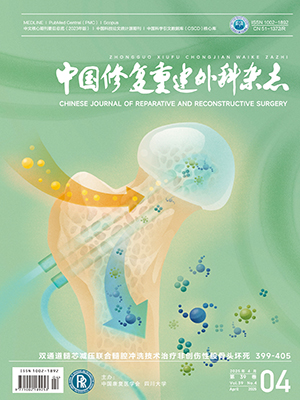| 1. |
Jain AK, Kumar J. Tuberculosis of spine: neurological deficit. Eur Spine J, 2013, 22(Suppl 4): 624-633.
|
| 2. |
金大地. 化疗和外科干预并重, 进一步提高脊柱结核治疗水平. 中华骨科杂志, 2005, 25(2): 65-67.
|
| 3. |
罗卓荆. 脊柱结核为什么要彻底清除病灶. 中国脊柱脊髓杂志, 2010, 20(10): 797-798.
|
| 4. |
高永建, 欧云生, 权正学, 等. 胸腰椎脊柱结核外科治疗的研究进展. 中国修复重建外科杂志, 2018, 32(1): 112-117.
|
| 5. |
Bridwell KH, Lenke LG, McEnery KW, et al. Anterior fresh frozen structural allografts in the thoracic and lumbar spine. Do they work if combined with posterior fusion and instrumentation in adult patients with kyphosis or anterior column defects. Spine (Phila Pa 1976), 1995, 20(12): 1410-1418.
|
| 6. |
杨智贤, 彭小忠, 武振国, 等. 脊柱结核外科治疗骨缺损的修复. 中国组织工程研究与临床康复, 2011, 15(30): 5665-5668.
|
| 7. |
Yin XH, Liu ZK, He BR, et al. Single posterior surgical management for lumbosacral tuberculosis: titanium mesh versus iliac bone graft: A retrospective case-control study. Medicine (Baltimore), 2017, 96(51): e9449.
|
| 8. |
Wang YX, Zhang HQ, Li M, et al. Debridement, interbody graft using titanium mesh cages, posterior instrumentation and fusion in the surgical treatment of multilevel noncontiguous spinal tuberculosis in elderly patients via a posterior-only. Injury, 2017, 48(2): 378-383.
|
| 9. |
Kanayama M, Cunningham BW, Haggerty CJ, et al. In vitro biomechanical investigation of the stability and stress-shielding effect of lumbar interbody fusion devices. J Neurosurg, 2000, 93(2 Suppl): 259-265.
|
| 10. |
Gao Y, Ou Y, Deng Q, et al. Comparison between titanium mesh and autogenous iliac bone graft to restore vertebral height through posterior approach for the treatment of thoracic and lumbar spinal tuberculosis. PLoS One, 2017, 12(4): e0175567.
|
| 11. |
邹沙沙, 陈婷婷, 田汝辉, 等. 自体髂骨植骨供骨区并发症的 Meta 分析. 中国组织工程研究, 2013, 17(5): 931-937.
|
| 12. |
Harris WH. Management of the deficient acetabulum using cementless fixation without bone grafting. Orthop Clin North Am, 1993, 24(4): 663-665.
|
| 13. |
周磊, 李明, 刘培来, 等. 一期前路病灶清除钛网植骨融合内固定治疗胸腰椎结核. 中国矫形外科杂志, 2007, 15(7): 487-490.
|
| 14. |
Soares do Brito J, Batista N, Tirado A. Surgical treatment of spinal tuberculosis: an orthopedic service experience. Acta Med Port, 2013, 26(4): 349-356.
|
| 15. |
王丛, 陈根元, 杨成业, 等. 改良后路病灶清除打压植骨内固定治疗胸腰椎结核. 中国脊柱脊髓杂志, 2011, 21(10): 835-838.
|
| 16. |
Liu JM, Zhou Y, Peng AF, et al. One-stage posterior surgical management of lumbosacral spinal tuberculosis with nonstructural autograft. Clin Neurol Neurosurg, 2017, 153: 67-72.
|
| 17. |
Xu Z, Wang X, Wu P, et al. Surgical treatment for mono-segmental lumbar tuberculosis by single-stage posterior debridement, compact bone grafting and posterior single-segment fixation. Injury, 2015, 46(7): 1311-1316.
|
| 18. |
Hu MW, Liu ZL, Zhou Y, et al. Posterior lumbar intebody fusion using spinous process and laminae. J Bone Joint Surg (Br), 2012, 94(3): 373-377.
|
| 19. |
官众, 许勇, 任磊, 等. 三种不同植骨方式在胸、腰椎结核手术治疗中的观察. 中国脊柱脊髓杂志, 2013, 23(6): 488-492.
|
| 20. |
Liu JM, Chen XY, Zhou Y, et al. Is nonstructural bone graft useful in surgical treatment of lumbar spinal tuberculosis?: A retrospective case-control study. Medicine (Baltimore), 2016, 95(35): e4677.
|
| 21. |
Rajasekaran S. Kyphotic deformity in spinal tuberculosis and its management. Int Orthop, 2012, 36(2): 359-365.
|
| 22. |
Tosun B, Erdemir C, Yonga O, et al. Surgical treatment of thoracolumbar tuberculosis: a retrospective analysis of autogenous grafting versus expandable cages. Eur Spine J, 2014, 23(11): 2299-2306.
|
| 23. |
王新涛, 闫景龙, 杨显声, 等. 微小颗粒骨移植骨细胞活性的实验研究. 中华创伤骨科杂志, 2008, 10(3): 260-265.
|
| 24. |
夏景君, 阎景龙, 张志鹏, 等. 颗粒骨和块状骨对骨髓基质细胞作用的实验研究. 哈尔滨医科大学学报, 2002, 36(2): 141-143.
|
| 25. |
Li H, Zou X, Xue Q, et al. Effects of autogenous bone graft impaction and tricalcium phosphate on anterior interbody fusion in the porcine lumbar spine. Acta Orhop Scand, 2004, 75(4): 456-463.
|
| 26. |
Yao Y, Zhang H, Liu M, et al. Prognostic factors for recovery of patients after surgery for thoracic spinal tuberculosis. World Neurosurg, 2017, 105: 327-331.
|
| 27. |
孙天胜, 沈建雄, 刘忠军, 等. 中国脊柱手术加速康复——围术期管理策略专家共识. 中华骨与关节外科杂志, 2017, 10(4): 271-279.
|
| 28. |
吴鹏, 欧云生, 刘德龙, 等. 后路经单侧椎弓根病灶清除植骨内固定治疗胸腰椎结核的疗效分析. 中国修复重建外科杂志, 2015, 29(10): 1259-1264.
|




